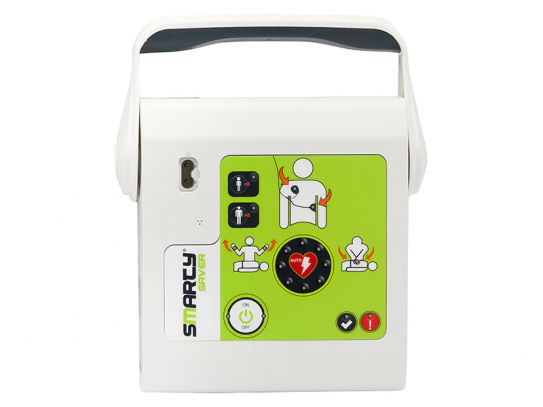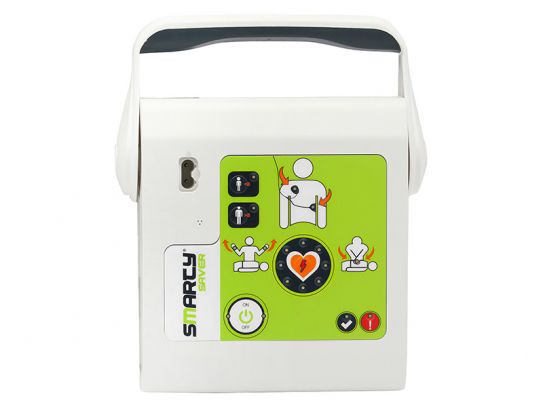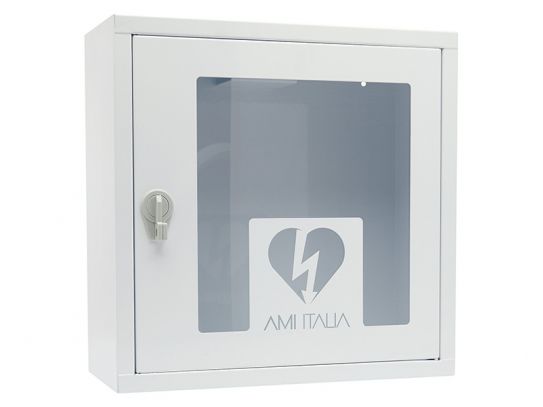Defibrillators
Be Prepared for the Unexpected With a Defibrillator
When every second counts, trust the power of our defibrillator range to save lives. Our state-of-the-art devices are designed with both ease of use and effectiveness in mind, making them the perfect addition to any facility.
Our defibrillators are suitable for both professional and lay rescuer, Easy to use with clear voice and visual prompts, Help to ensure that a victim of sudden cardiac arrest receives the timely treatment they need to increase their chance of survival.
With a range of models to choose from, including both semi-automatic and fully automatic options, our defibrillators are tailored to meet the needs of any environment.
Whether you're looking to equip a hospital, school, gym, or public space, we have a solution that's right for you.
What Are Defibrillators?
A defibrillator, also known as an automated external defibrillator (AED), is a medical device that can be used to treat sudden cardiac arrest. It is a portable device that delivers an electric shock to the heart through the chest wall, in an attempt to restore a normal heart rhythm.
Sudden cardiac arrest occurs when the heart's electrical system malfunctions, causing the heart to beat in an abnormal rhythm. This can lead to the heart not pumping blood effectively, and if left untreated, can quickly lead to death. Defibrillation with an AED is the most effective treatment for restoring a normal heart rhythm, and the sooner it is done, the better the chances of survival.
Defibrillators can be used by trained lay rescuers or healthcare professionals, and are designed to be easy to use. Many modern defibrillators include built-in instruction and coaching, to guide the user through the process of providing treatment.
AEDs are usually found in public places like airports, sports centres and schools, as well as ambulances, helicopters, and some cars.
What Are Some Common Uses for Defibrillators?
Some common uses for defibrillators include:
- Emergency medical services (EMS): Defibrillators are an essential piece of equipment in ambulances and other emergency vehicles. They are used by paramedics and other first responders to treat patients suffering from sudden cardiac arrest.
- Hospitals: Defibrillators are used in hospitals as part of the code blue teams that respond to cardiac emergencies. They are also used in emergency departments, intensive care units, and other areas of the hospital where patients may be at risk for sudden cardiac arrest.
- Public access defibrillation (PAD) programs: PAD programs aim to increase the availability of defibrillators in public places, such as airports, shopping malls, and sports stadiums. The goal of these programs is to improve survival rates from sudden cardiac arrest by making defibrillators more widely available to the public.
- Schools and workplaces: Defibrillators can be found in many schools and workplaces as part of a comprehensive safety plan. It could be used in case of any emergency.
- Home use: Some defibrillators are available for home use and are intended for use by individuals or family members who are at high risk of sudden cardiac arrest.
- Recreational and sports venues: Many sports venues and recreational facilities have defibrillators on site to be used in case of emergency.
It's important to note that while the use of defibrillators has been proven to be a key factor in increasing the survival rate of sudden cardiac arrest cases, it's always best to get professional help as soon as possible in order to have the best outcome.
What Are the Different Types of Defibrillators?
There are two main types of defibrillators: manual and automated.
- Manual defibrillators: Manual defibrillators, also known as semi-automatic defibrillators, require the user to manually deliver the electric shock to the patient. The defibrillator will analyse the patient's heart rhythm and indicate whether a shock is required, but the user must press a button to deliver the shock.
- Automated external defibrillators (AEDs): Automated external defibrillators, also known as fully automatic defibrillators, are designed to be used by non-medical personnel. These devices will automatically analyse the patient's heart rhythm and deliver a shock if necessary. Many modern AEDs include built-in instruction and coaching, to guide the user through the process of providing treatment.
It's worth noting that these are not the only types of defibrillators, but they are the most common ones used. Different types of defibrillators can be used depending on the patient's condition and the environment the device is being used in.
What Are the Key Features to Consider When Choosing Defibrillators?
There are several key features to consider when choosing a defibrillator:
- Ease of use: Defibrillators should be easy to use, even for people who have never used one before. Look for models that include clear voice prompts and visual instructions.
- Automation: Fully automatic defibrillators, also known as automated external defibrillators (AEDs), are more user-friendly than manual defibrillators and can be used by non-medical personnel.
- Durability: Defibrillators should be able to withstand the rigours of everyday use and be easy to maintain. Look for models that are built to withstand harsh conditions and are made of durable materials.
- Battery life: Defibrillators should have a long battery life so that they can be used for an extended period of time without needing to be recharged. Also, make sure the device has an indicator that shows the battery level.
- Weight and portability: Defibrillators should be lightweight and portable, making them easy to transport and use in different locations.
- Cost: Consider the cost of the defibrillator, as well as the cost of replacement parts and batteries, and the cost of training for staff.
- Training and Support: It's important to ensure that the company you are buying from provides easy access to the training and support to be able to use the device in the best possible way.
- Warranty and Service : Make sure to check the device warranty and after-sales service availability before purchasing.
- Paediatric capability: If the defibrillator will be used in a place where there are children, it's important to choose a model that is capable of providing therapy for both adults and paediatric patients.
Ultimately, the best defibrillator for your organisation will depend on your specific needs and budget. It's important to work with a reputable vendor who can provide expert guidance on selecting the right defibrillator for your facility.
How Do Defibrillators Work?
Defibrillators work by delivering an electric shock to the heart through the chest wall, in an attempt to restore a normal heart rhythm. When a person suffers from sudden cardiac arrest, their heart's electrical system malfunctions and the heart beats in an abnormal rhythm, usually a ventricular fibrillation (VF) which is a rapid and irregular heart rhythm. The VF can quickly lead to death.
- Defibrillators use two paddles or adhesive pads that are placed on the patient's chest. The defibrillator then delivers an electric shock to the heart through these paddles or pads. The shock works by depolarizing a critical mass of heart muscle, effectively interrupting the abnormal rhythm and allowing the normal sinus rhythm to be reestablished.
- There are two main types of defibrillators: manual and automated. Manual defibrillators, also known as semi-automatic defibrillators, require the user to manually deliver the electric shock to the patient after the device has analyze the patient's heart rhythm and indicated that a shock is required. Automated external defibrillators (AEDs), also known as fully automatic defibrillators, are designed to be used by non-medical personnel and will automatically deliver the shock if necessary after analysing the patient's heart rhythm.
It's important to note that defibrillation is a vital step in the treatment of cardiac arrest, but it should be used in conjunction with cardiopulmonary resuscitation (CPR) in order to achieve the best outcome.
Are Defibrillators Safe to Use?
Defibrillators are generally considered to be safe to use. They have been extensively tested and have been proven to be an effective treatment for sudden cardiac arrest. When used as directed, the benefits of defibrillation far outweigh any potential risks.
Automated external defibrillators (AEDs) are designed to be used by non-medical personnel and are equipped with safety features to minimise the risk of injury. For example, they will not deliver a shock if the patient has a pulse or if the device detects that the patient is still breathing. They are also equipped with visual and audio prompts to guide the user through the process of providing treatment.
However, as with any medical device, there are potential risks associated with the use of defibrillators. For example, if the device is not used correctly or if the electrodes or other parts are not properly maintained, the device may not work correctly and may not be able to deliver a shock when needed. In rare cases, defibrillation can also cause injury or death, particularly if the patient has certain pre-existing medical conditions.
To minimise the risks, it is important to ensure that the device is properly maintained, and that any person who will be using the device is properly trained in its use. Also, when used as part of a comprehensive cardiac emergency response plan, which includes CPR and advanced life support, the benefits of defibrillation are greatly increased.
How Do You Maintain a Defibrillator?
Maintaining a defibrillator is important to ensure that the device is in good working order and is ready to use when needed. The specific maintenance requirements will vary depending on the device and the manufacturer, but here are some general guidelines for maintaining a defibrillator:
- Check the battery: The battery should be checked regularly to ensure that it is fully charged and in good working order. If the battery is low, it should be recharged or replaced as necessary.
- Replace electrodes: The electrodes (pads) that are placed on the patient's chest should be replaced regularly. The frequency of replacement will depend on the device and the manufacturer, but it is typically recommended to replace them after each use, or at least once every two years.
- Clean the device: The device should be kept clean and free of dust and debris to ensure proper operation. It's recommended to wipe the device with a damp cloth and mild detergent.
- Perform routine tests: The device should be tested regularly to ensure that it is in good working order. This may include testing the battery, ensuring that the device can properly analyse the patient's heart rhythm, and checking the device's readiness indicators.
- Keep the user manual: The user manual should be kept in an accessible place and should be consulted for specific maintenance instructions for your device.
It's important to follow the manufacturer's instructions for maintaining your defibrillator and to have it serviced by a qualified technician if needed. Maintaining your defibrillator in good working condition can help ensure that it will be ready to use when needed and improve the chances of survival in case of sudden cardiac arrest.


